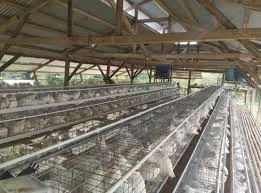Optimizing Space for Raising Rabbits Efficiently in Small Cages
Nov . 08, 2024 06:18 Back to list
Optimizing Space for Raising Rabbits Efficiently in Small Cages
The Optimal Rabbit Cage for Fattening A Comprehensive Guide
Rabbits have become increasingly popular as livestock animals, particularly for their meat production. With the growing demand for rabbit meat, optimizing their living conditions is crucial for ensuring their health and maximizing their weight gain. One of the essential elements in raising rabbits for fattening is the design of their cages. In this article, we will explore the key aspects to consider when creating an optimal rabbit cage that supports efficient fattening.
Ideal Cage Size and Structure
Size is perhaps the most critical factor in constructing a rabbit cage for fattening. An adequately sized cage allows rabbits to move freely, ensuring they can exercise while also providing a comfortable environment. The general guideline is to provide at least 6 square feet of space per rabbit. However, for heavier breeds like New Zealand or Californian rabbits, a larger space is recommended to avoid stress and promote weight gain.
The structure of the cage should facilitate good airflow and easy cleaning. Wire floors are common choices, as they help prevent the accumulation of waste. However, it is advisable to place wooden boards or materials to provide some sections with solid floors for resting, as wire floors can be hard on their feet.
Proper Ventilation and Temperature Control
Ensuring proper ventilation is vital in maintaining a healthy environment for fattening rabbits. Stagnant air can lead to the buildup of ammonia from urine and waste, posing health risks to the animals. Incorporating ventilation holes or fans can improve air circulation. Additionally, the cage should be placed in a shaded area to regulate temperature, as rabbits are susceptible to heat stress. Maintaining an ideal temperature between 60°F to 70°F (15°C to 21°C) is crucial for their well-being and optimal weight gain.
Nesting Areas and Comfort
Fattening rabbits require secure and comfortable spaces within their cages. This can be achieved by offering nesting boxes filled with straw or hay. These areas allow rabbits to feel safe and reduce stress, which can otherwise hinder their growth. Stress in rabbits can lead to reduced feed intake and lower weight gain, so prioritizing their comfort is essential.
Feeding Considerations
fattening rabbit cage

The design of the cage should also accommodate feeding and watering systems effectively. Rabbits thrive on a diet rich in high-quality hay, fresh vegetables, and specially formulated pellets. Feeding stations should be placed in a way that allows all rabbits easy access to food without creating competition. Automatic feeders can be beneficial in ensuring that all rabbits receive adequate nutrition consistently.
Additionally, providing a constant supply of fresh water is essential. Water bottles or troughs should be installed securely to avoid spills and contamination. Hydration is key to maintaining the overall health of the rabbits and aiding in their weight fattening process.
Hygiene Maintenance
A clean environment is paramount for promoting the health of fattening rabbits. The cage should be designed for easy cleaning, with removable trays to catch waste. Regularly cleaning the cage helps minimize the risk of disease and parasites, which can severely impact growth rates.
Incorporating materials that are easy to disinfect, like plastic or metal, can also aid in maintaining hygiene standards. Ensuring that bedding is changed frequently will help control odors and keep the rabbits comfortable.
Socialization and Grouping
Rabbits are social creatures that thrive in groups. When fattening rabbits, consider how they are grouped within the cages. Caging them in pairs or small groups can help reduce stress and encourage natural behaviors, which positively influences their growth. However, avoid overcrowding, as it can lead to aggression and competition for resources.
Conclusion
Creating an optimal rabbit cage for fattening involves careful consideration of size, structure, ventilation, comfort, feeding, and hygiene. By prioritizing the rabbits’ needs and providing a suitable environment, producers can ensure that their rabbits thrive, ultimately leading to efficient weight gain and healthier livestock. The importance of well-designed rabbit housing cannot be overstated, as it directly impacts the success of rabbit fattening operations. As demand for rabbit meat continues to rise, investing in quality housing for these animals is a vital step for any rabbit producer.
-
Automatic Feeding Line System-Pan Feeder Nipple Drinker|Anping County Yize Metal Products Co., Ltd.
NewsJul.29,2025
-
Hot Sale 24 & 18 Door Rabbit Cages - Premium Breeding Solutions
NewsJul.25,2025
-
Automatic Feeding Line System Pan Feeder Nipple Drinker - Anping County Yize Metal Products Co., Ltd.
NewsJul.21,2025
-
Automatic Feeding Line System Pan Feeder Nipple Drinker - Anping County Yize Metal Products Co., Ltd.
NewsJul.21,2025
-
Automatic Feeding Line System - Anping Yize | Precision & Nipple
NewsJul.21,2025
-
Automatic Feeding Line System - Anping Yize | Precision & Nipple
NewsJul.21,2025






